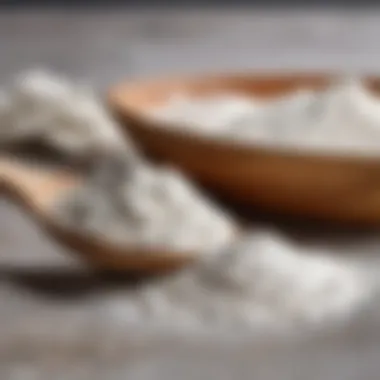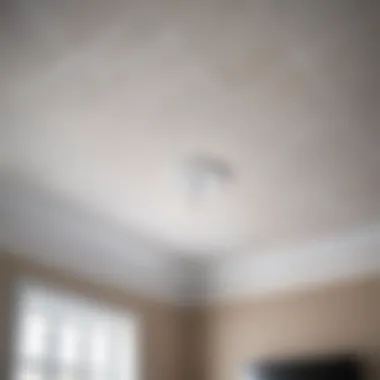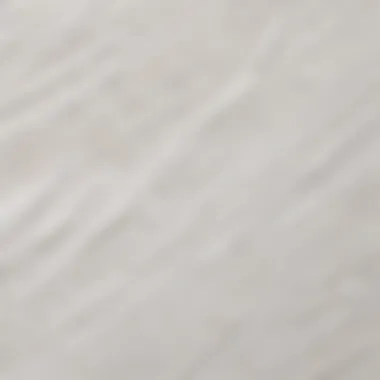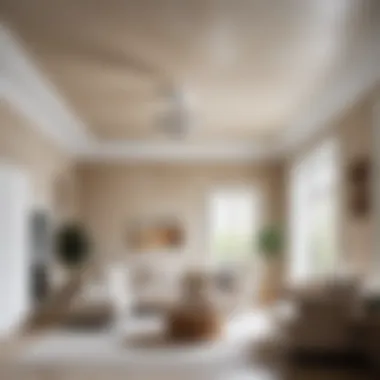How to Prepare Chalk Whitewash for Ceilings


Intro
Chalk whitewash is often overlooked in the world of DIY projects. However, it offers a unique charm and an eco-friendly approach to finishing ceilings. Its ability to give an airy feel while being easy to prepare and apply makes it a compelling choice for many.
Проектирование и планирование
Before starting your chalk whitewash project, careful planning ensures a smooth execution. This phase involves selecting an appropriate DIY project and evaluating the required time and resources.
Как выбрать проект для DIY
Choosing a project requires consideration of your skill level and the current state of your ceiling. If you are new to DIY, starting with a small area may help you gain confidence. Alternatively, if you have experience, you can tackle larger spaces. Think about how the whitewash will complement the existing design. Often, a lighter finish will provide a sense of openness, making it suitable for rooms with limited natural light.
Оценка времени и ресурсов
Assessing the time and resources required is crucial. Preparing the ceiling involves cleaning, priming, and drying time. You may need several hours per section, depending on the size of your ceiling. Adequate planning helps to avoid last-minute shortages. List all the tools and materials needed, allowing you to gather everything before starting.
Выбор материалов
The quality of your materials plays a significant role in the final outcome of any DIY project. Certain materials specifically enhance the characteristics of chalk whitewash, while others may be more suitable for different finishes.
Типы материалов для различных проектов
For chalk whitewash, the primary material needed is chalk itself, often in powdered form. You will also require water and, if desired, a binding agent like casein or polymer to improve adhesion. Consider the following:
- Chalk powder: Look for high-quality, calcium carbonate chalk.
- Water: Clean water is essential for mixing.
- Additives: Bindings prevent flaking and enhance durability.
Советы по покупке и экономии
Smart shopping can save you money. When buying chalk whitewash materials, consider purchasing in bulk, especially if the project covers a large area. Also, check local hardware stores for quality deals. Alternatively, local community groups may have resources or tips for budget-friendly shopping.
"Investing in quality materials may save you money on repairs or reapplications later.”
By understanding the project requirements, sourcing the right materials, and planning effectively, you set the stage for successful preparation and application of chalk whitewash on ceilings. This method not only adds character but also embraces sustainability, ideally suited for modern home improvement initiatives.
Prelude to Chalk Whitewash
Chalk whitewash is gaining renewed attention in the world of interior design and home improvement. Understanding this traditional coating is crucial for anyone interested in enhancing their space sustainably and effectively. Chalk whitewash offers a way to refresh ceilings while also providing a unique aesthetic appeal. It is not merely about aesthetics but also about embracing an eco-friendly alternative that is easy to apply and maintain.
Definition and Composition
Chalk whitewash consists primarily of chalk, water, and a binding agent. The basic formula allows it to adhere well to various surfaces, making it suitable for ceilings. The simplicity of its composition means it is non-toxic and poses little risk to health or the environment. Users can further customize their whitewash with pigments, giving it a distinctive hue or tone. This flexibility in composition enhances its practical usability and artistic potential.
Historical Context
Historically, whitewash was a common material used in various forms of architecture. In many regions, it served as a protective layer that not only covered surfaces but offered some degree of weather resistance. It has deep cultural roots, often associated with rural homes and traditional barns. The continuous use of this technique over centuries shows its effectiveness and enduring appeal. In today’s context, many designers and homeowners are revisiting whitewash as a nostalgic nod to the past while assessing its practical benefits for modern spaces.
Chalk whitewash reflects a craftsmanship that combines historical significance with contemporary application. Its revival is a testament to its enduring qualities that are both functional and aesthetically pleasing.
Materials Required
Understanding the materials required for preparing chalk whitewash is essential for a successful application. The choice of materials influences not only the quality of the whitewash but also its performance and longevity. Each material plays a peculiar role in achieving the desired outcome, making it crucial to select them with consideration.
Types of Chalk
There are various types of chalk available, each with distinct properties that can impact the overall quality of whitewash. Generally, calcium carbonate chalk is favored for its fine texture. It produces a smooth finish that enhances the aesthetic of the ceiling. On the other hand, powdered chalk offers a more textured finish, which could be ideal for specific styles or vintage looks. Each chalk type also should be pure and free of additives to ensure an even application.


Additional Materials
In addition to chalk, several other materials are necessary for preparing an effective whitewash. These include water, binders, and pigments.
Water
Water is a key component in the preparation of chalk whitewash. It serves as the medium that combines the chalk and binder, ensuring uniform distribution. The characteristic of water that is most relevant here is its ability to adjust consistency. By altering the water ratio, one can modify the thickness of the whitewash. This feature makes water a beneficial choice in achieving the desired texture for application. However, adding too much water may weaken the mixture and affect adhesion.
Binder
The binder is another crucial ingredient, often overlooked. Binders enhance the adhesion of the whitewash to the ceiling, ensuring durability. Common options include casein or natural latex. These binders hold the mixture together and improve longevity. A key characteristic of binders is their ability to promote flexibility once cured, which helps to reduce the likelihood of cracking. While using a binder may increase the cost slightly, the performance benefits often outweigh this drawback.
Pigments
Pigments serve to customize the color and appearance of the chalk whitewash. While traditional whitewash is primarily white, adding pigments allows for tone variations, catering to individual design preferences. The primary characteristic of pigments is their concentration, which affects the richness of color. Notably, using high-quality pigments will ensure better longevity and fade resistance. However, one should be cautious about the quantity of pigment added, as too much can hinder the whitewash's brightness and overall finish.
In summary, selecting quality materials is fundamental for preparing chalk whitewash. Each element, from the type of chalk to the choice of pigments, significantly contributes to the final result.
Preparing the Chalk Whitewash
Chalk whitewash serves as an eco-friendly and aesthetically pleasing option when it comes to decorating ceilings. The preparation of chalk whitewash is an essential step, as the overall quality of the final application hinges upon this process. This section will explain the significance of preparing chalk whitewash effectively. Proper preparation ensures that the mixture adheres well to the ceiling surface and maintains a uniform appearance. Furthermore, understanding how to measure ingredients correctly, mix them properly, and achieve the desired consistency cannot be overstated.
Measuring Ingredients
Measuring the right ingredients is crucial for the success of chalk whitewash. It determines not only the application ease but also the durability of the finish. Typically, a base ratio can include three parts chalk to one part water. To achieve a richer finish, one might consider adding a binder, like casein or glue. Measuring precise amounts using tools like measuring cups or a kitchen scale ensures accuracy. Over- or under-measuring can lead to a mixture that is either too thick or too thin, leading to application issues later on. For best results, keep your measuring tools clean and dry to avoid contamination.
Mixing Process
Mixing is the heart of preparing chalk whitewash. Once you have the measured chalk and water combined, you should use a whisk or a paddle mixer for thorough integration. Start by adding the water slowly to the chalk; this gradual process helps prevent any lumps from forming. Blend until all particles are dissolved, and the mixture appears smooth and creamy. If you decide to incorporate pigments for coloring, add them gradually while continuing to mix. Testing small quantities can assist in finding the perfect shade. Keep the mixing container clean throughout to avoid debris that could affect the finish.
Achieving the Desired Consistency
The consistency of chalk whitewash can greatly affect its performance. A well-prepared mixture should flow smoothly but not be overly watery. After thorough mixing, you should test the consistency using a brush or a stick. The mixture should coat the surface without dripping excessively. If it's too thick, add water in small increments. If it's too thin, you may need to whisk in more chalk. The ideal consistency resembles a thick soup; this allows for even application while ensuring that it adheres well to start surfaces.
"Achieving the correct consistency is crucial for the success of any chalk whitewash project."
By carefully measuring, mixing, and adjusting, you can prepare a superior chalk whitewash that enhances both the function and aesthetic of your ceilings. Understanding these elements comprehensively results in a reliable and effective application process.
Application Techniques
Application techniques are vital in ensuring a successful chalk whitewash finish on ceilings. Proper techniques lead to an even distribution of the product while minimizing streaks and drips. This section will cover the tools needed for effective application, the importance of prepping the ceiling surface before applying the whitewash, and how to achieve even coverage during the application process.
Tools Needed for Application
Brushes
Brushes are a fundamental tool when applying chalk whitewash. Their design allows for precise application, especially in corners and edges where larger tools may struggle. A key characteristic of brushes is their bristle stiffness, which can affect the finish achieved. Softer bristles offer a smoother application, while firmer bristles can create texture. The unique feature of brushes is their ability to control the amount of chalk whitewash applied, making them a popular choice in detailed work.
Advantages of using brushes include flexibility in reaching difficult areas and the capability to apply different layers for depth. However, they may require more physical effort and time compared to other tools.
Rollers
Rollers are another effective option for applying chalk whitewash. They cover larger areas quickly, making them suitable for expansive ceilings. The main characteristic of rollers is their surface material; a well-chosen roller can evenly distribute the whitewash while minimizing air bubbles.
Unlike brushes, rollers excel at achieving a uniform coat with less effort. The unique feature of rollers is their ability to hold a considerable amount of whitewash, leading to faster application. The disadvantage could be their ineffectiveness in tight spaces and corners.


Sprayers
Sprayers offer a modern approach to applying chalk whitewash, especially for large, flat surfaces. Their key characteristic is the ability to atomize the product, allowing for an even and fine mist. A sprayer can save time and effort, providing a smooth finish without brush marks.
The unique feature of sprayers is their speed, making them beneficial for extensive projects. However, they require careful adjustment to prevent overspray and ensure an even application. Using a sprayer may also necessitate additional cleanup and setup.
Prepping the Ceiling Surface
Before applying chalk whitewash, it is crucial to prep the ceiling surface adequately. A clean and smooth surface ensures better adhesion of the chalk coating. This can involve cleaning to remove dust, grease, or other contaminants that could affect the finish. Depending on the condition of the ceiling, the prep might also involve filling in cracks or holes, sanding rough areas, or applying a primer to enhance durability. Proper preparation prevents common issues such as peeling or uneven color.
Technique for Even Coverage
Achieving even coverage when applying chalk whitewash is essential for a professional-looking finish. Begin by applying the whitewash in sections, using overlapping strokes to blend the edges. Whether using brushes, rollers, or sprayers, a consistent speed and pressure will help maintain an even coat. It is advisable to work from one corner to the opposite side, ensuring that areas treated last remain workable.
A good technique to follow is the "W" pattern when using brushes or rollers. This method helps distribute the whitewash uniformly while minimizing streaks. Allow sufficient drying time between layers if multiple coats are needed, which will enhance the depth and overall impressiveness of the finish.
Tip: Always test a small area first to ensure satisfaction with the color and finish before proceeding with the entire ceiling.
Advantages of Chalk Whitewash
Chalk whitewash has emerged as a favored choice among those seeking to renovate their ceilings. The advantages it brings forward are significant and distinct. They focus on eco-friendliness, aesthetic appeal, and cost-effectiveness. Each of these elements not only enhances the overall ambience of a space but also aligns with sustainability goals.
Eco-Friendliness
A primary benefit of chalk whitewash is its ecological impact. Made from natural materials, chalk whitewash decomposes easily and does not release harmful toxins into the environment. Unlike traditional paint, which often contains volatile organic compounds (VOCs), chalk whitewash is safe for indoor air quality. This makes it a reasonable choice for homeowners who are environmentally conscious.
By opting for chalk whitewash, you contribute to a reduced carbon footprint. This aligns with wider sustainable building practices, focusing on renewable and natural resources. In addition, chalk whitewash promotes breathability in walls and ceilings, helping to regulate humidity and prevent mold growth. A natural finish not only ensures health benefits but also supports a more sustainable approach to home improvement.
Aesthetic Appeal
Aesthetic considerations play a pivotal role in the preference for chalk whitewash. It offers a unique, soft finish that enhances the beauty of traditional and contemporary spaces alike. The matte quality of the finish is particularly appealing. It does not reflect excessive light but instead absorbs it in a way that softens the overall visual space. This characteristic enables a tranquil atmosphere, conducive to relaxation.
Moreover, chalk whitewash can be manipulated to achieve various looks through dilution and layering. A skilled application allows for texture variations. This adaptability makes it suitable across different styles, from rustic to modern.
Homeowners can also experiment with pigments, allowing customization for those who wish to infuse color without the commitment of full solid paint. Thus, chalk whitewash offers versatility that resonates well with designers and builders alike.
Cost-Effectiveness
When considering budget-friendly options for ceiling renewals, chalk whitewash stands out. The materials required are inexpensive yet potent. Chalk itself, often sourced from local suppliers, is readily available and does not demand high-cost investment. Other ingredients, such as water and binders, add minimal expenses.
In addition to initial cost savings, maintenance expenses are lower with chalk whitewash. Regular upkeep involves simple washing and possibly a light reapplication over time. Unlike conventional paints, which often require extensive sanding or priming for repairs, a chalk whitewash ceiling remains forgiving.
Moreover, do-it-yourself enthusiasts can easily prepare and apply chalk whitewash. This opens opportunities for self-financed projects, saving labor costs while also delivering personal satisfaction through hands-on work.
Safety Considerations
When working with chalk whitewash for ceilings, it is essential to prioritize safety. The process involves various materials and tools that may pose risks if proper precautions are not taken. Ensuring a safe working environment not only protects the individual performing the task but also contributes to the quality of the finished product. Here are key elements to consider:
Working Environment
Creating a safe working environment is the first step in any DIY project involving chalk whitewash. A well-ventilated area reduces the concentration of dust and fumes resulting from mixing and applying materials. Ensure the space is clear of unnecessary clutter to prevent accidents, such as trips and falls. Additionally, it's advisable to work at a comfortable height to avoid strain. Use sturdy ladders or scaffolding if needed, positioning them on stable ground to minimize the risk of collapse. Keeping all materials organized and within reach will enhance efficiency and safety.
In a poorly lit area, visibility decreases, increasing the chances of error. Make sure to utilize adequate lighting when preparing and applying whitewash. This will help in monitoring the consistency of the mixture and ensure even application across the ceiling.
Protective Gear


Wearing appropriate protective gear is crucial when preparing and applying chalk whitewash. This should include:
- Safety goggles: These protect your eyes from dust and splashes during the mixing and application process.
- Dust mask or respirator: This is essential when mixing chalk and other components to avoid inhaling harmful particles.
- Gloves: Wearing gloves prevents skin irritation from prolonged contact with chalk and other chemicals used in the mixture.
- Old clothing and work shoes: Since the process can be messy, using old or disposable clothing can save valuable garments from potential damage.
Keep in mind that safety gear should fit properly and not restrict movement, allowing for a comfortable yet protected work experience.
"Safety first is safety always."
By adhering to these safety considerations, individuals can minimize hazards associated with the chalk whitewash process, ensuring a more enjoyable and successful DIY experience.
Common Mistakes to Avoid
Understanding common mistakes in preparing and applying chalk whitewash is vital for achieving the desired results. These errors can lead to unsatisfactory finishes or more extensive problems down the line. By recognizing and avoiding these pitfalls, one can ensure a successful application that enhances the aesthetic appeal of ceilings. The following sections elaborate on two significant mistakes: ignoring surface preparation and improper mixing ratios.
Ignoring Surface Preparation
Surface preparation is crucial in any painting or whitewashing project. Neglecting this step can result in a variety of issues, including poor adhesion and uneven finishes. Before applying chalk whitewash, the ceiling surface must be clean, dry, and free of contaminants. This involves removing dust, grease, or old paint that may hinder the new finish.
Additionally, any damaged areas should be repaired. For instance, small cracks can be filled with spackle or plaster. If the surface is porous or uneven, priming may be necessary to ensure the chalk whitewash adheres properly. Proper preparation establishes a solid foundation and can significantly enhance the longevity and appearance of the finish.
Improper Mixing Ratios
The mixing of chalk whitewash is also a common area where mistakes occur. Achieving the right balance of chalk, water, and binder is essential for optimal results. An improper ratio can lead to a mixture that is too thin or too thick, affecting the coverage and overall appearance of the ceiling.
For example, if there is too much water, the whitewash may run or drip during application, creating streaks or uneven patches. Conversely, too little water can lead to a paste-like consistency that is difficult to spread evenly. It is advisable to start with a basic ratio and adjust according to the texture and desired finish. Keeping track of the ratios used can help in maintaining consistency across multiple batches.
"Proper mixing and stirring techniques can prevent many problems often seen in DIY chalk whitewashing projects."
Maintenance of Chalk Whitewash
Maintaining chalk whitewash is essential for ensuring its longevity and appearance. Regular upkeep can prevent the need for complete reapplication, which is more time-consuming and labor-intensive. The chalk's natural properties can lead to fading or discoloration over time if proper care is not taken. By implementing a structured maintenance routine, you can preserve both the aesthetic and functional qualities of the finish. This is particularly important in high-traffic areas or spaces exposed to moisture.
Regular Cleaning Techniques
Cleaning is a critical aspect of maintaining chalk whitewash. It is important to address dust and stains promptly. Here are some techniques to keep the whitewash looking fresh:
- Dusting: Use a soft, dry cloth or a microfiber duster to gently remove dust from the surface. It’s important to avoid scratching the paint.
- Spot Cleaning: For stains, a damp cloth can be used, but be careful to use minimal water to prevent any damage to the whitewash. If a stain persists, a gentle soap solution can be applied lightly, with immediate wiping afterward.
- Avoid Harsh Cleaners: Strong chemicals can degrade the chalk finish. Stick to mild cleaning solutions, as harsh treatments might strip the surface and lead to more paint loss.
Implementing these simple cleaning techniques will prolong the life of chalk whitewash and keep it looking sharp.
Refinishing Options
Refinishing chalk whitewash is sometimes necessary to restore its original look or adapt to changing decor. It is not as daunting as it sounds and can be done effectively with proper knowledge. Here are some refinishing options:
- Reapplication of Whitewash: A light reapplication of whitewash can simply refresh the surface. This allows for an even appearance without intense preparation.
- Adding Pigments: If the original brightness has faded, consider adding pigments to the mix. This can customize the color to fit a new design scheme.
- Texture Enhancement: For those wishing to update the look further, applying a thin layer of plaster over the existing chalk can provide a textured finish that complements various interior styles.
The goal is to ensure the chalk whitewash remains functional and visually appealing. Monitoring the surface and adapting the maintenance routines accordingly is vital for achieving long-lasting results.
Closure
Summary of Benefits
Chalk whitewash presents numerous advantages that merit attention:
- Eco-Friendliness: Made from natural materials, it is a sustainable choice. This is a significant consideration for individuals looking to reduce their environmental footprint in home improvement projects.
- Aesthetic Appeal: The soft, subtle finish of chalk whitewash offers a rustic look that can complement various interior styles. It allows for a myriad of creative expressions.
- Cost-Effectiveness: Given its simple preparation and application process, chalk whitewash is budget-friendly. The ingredients are often inexpensive and readily available.
- Durability: When applied correctly, chalk whitewash can withstand the test of time, maintaining its charm and integrity over the years.
Final Thoughts on DIY Application
Engaging in DIY projects, such as applying chalk whitewash, offers a rewarding experience. It not only brings a personal touch to one's living space but also allows for creative exploration. While the idea of taking on a project can seem daunting, thorough preparation and attention to detail can yield satisfying results.
Whether for a small room or an entire ceiling, chalk whitewash can transform an area with ease. Individuals should remember to follow guidelines about material preparation and application techniques to achieve the best outcomes.
In summary, embracing the traditional method of chalk whitewash is not just functional; it is also an opportunity to create aesthetically appealing spaces that reflect creativity and sustainability.







